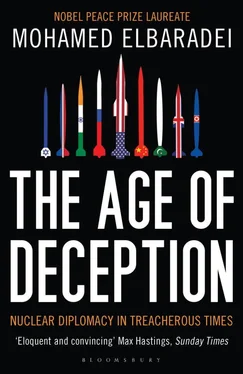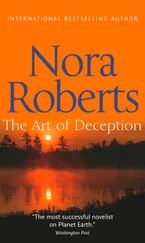As expected, the North Koreans refused. They insisted they would not provide the Agency with the requested access.
The IAEA Board of Governors called for a special session. The event was memorable, a closed-door session with restricted attendance. The Agency’s concerns about North Korea’s nuclear program were presented in three parts: first, the technical background, in terms of the discrepancies as observed and analyzed; second, the arguments justifying additional access; and third, the evidence of concealment.
The concealment portion involved the presentation of satellite imagery supplied by U.S. intelligence. Until this point, the satellite imagery of North Korea’s facilities had been made available to us only during briefings at the U.S. Mission, with a security officer, an elderly chap, stationed at the door of the briefing room—presumably to ensure that the IAEA inspectors would not run off with the images. The United States had altered the resolution of the images somewhat, in order to disguise their actual surveillance capability. Still, the windows of the buildings could clearly be discerned.
This was the first time in the history of the IAEA that the Secretariat had shared information supplied by Member State intelligence in a Board setting. Member States had historically been very uneasy about the Agency’s use of any information obtained through national intelligence agencies. The case of Iraq was an exception, but the Iraq inspections had been conducted under the extraordinary mandate of Security Council Resolution 687. This Board meeting on North Korea thus served as a quiet milestone: in subsequent years, referring to the use of intelligence would become much more routine.
Five weeks later, a Board resolution was proposed to refer the North Korean noncompliance to the UN Security Council. The response from Pyongyang was swift and decisive. Kim Il Sung’s regime issued terse edicts that restricted the Agency’s inspections, making it nearly impossible to investigate further the history of their nuclear program. However, North Korea remained in the NPT, and the Agency maintained its ability at least to verify North Korea’s declared nuclear material.
Possibly this opening remained because the Security Council did not take forceful action. China, with its emphasis on dialogue and restraint, refused to endorse certain steps, such as the imposition of sanctions or the adoption of a resolution demanding that North Korea agree not to make nuclear weapons and not to withdraw from the NPT. Because of China’s opposition, the resolution that was finally adopted “called on” but did not “require” North Korea to permit additional IAEA inspections. Resolution 825 was approved in May 1993, with China and Pakistan abstaining.
A stalemate now set in and continued through most of 1993. IAEA inspectors had to negotiate every inspection, even when merely servicing the Agency’s monitoring cameras and checking the film. Finally, in the spring of 1994, the situation came to a head. North Korea announced that they would begin removing the entire core of the reactor at Yongbyon—a total of eight thousand rods of spent fuel—for storage and potential reprocessing. This was a critical moment. By taking a specific array of samples at this stage, Agency inspectors would be able to verify the history of the reactor’s operation. The key question was whether this was still the original reactor core or whether an earlier core had at some point been removed and replaced but not reported to the IAEA. Since reactor operation produces plutonium, an unreported core of spent reactor fuel could already have been reprocessed in secret to separate the plutonium. By analyzing the material in these samples, the IAEA would be able to determine the amount of spent fuel (and by extension, the amount of plutonium) available to North Korea for possible diversion to weapons.
The North Koreans were uncooperative, at one point discharging so much fuel that the IAEA lost the continuity of this history. Once again, this confrontation generated a report to the IAEA Board; once again, the Board debate led to a report to the Security Council. This time the Board’s resolution was harsher: in particular, it ordered cutbacks to the technical cooperation the Agency had traditionally given North Korea, such as assistance with medical, agricultural, and other humanitarian applications of nuclear technology.
North Korea shot back by relinquishing its membership in the IAEA and declaring that it would withdraw from the NPT. This withdrawal was then “suspended,” at the urging of the United States, just one day before it was to go into effect. Nonetheless, cooperation with the Agency was deteriorating rapidly.
In the summer of 1994, the United States began negotiating directly with North Korea, in Geneva, on a bilateral arrangement intended to improve the situation. Former president Jimmy Carter was heavily involved, as a private citizen; his meetings with an aging Kim Il Sung in Pyongyang helped move the negotiations along. The result was the so-called Agreed Framework: an ad hoc, one-of-a-kind agreement that would remain in place for years to come.
The Agreed Framework was based on “action for action,” according to a preset timeline. The primary provisions were that North Korea would freeze the operations of its existing nuclear program, including the existing five-megawatt research reactor and nuclear fuel reprocessing facility at Yongbyon and two new facilities under construction, a fifty-megawatt reactor and a two-hundred-megawatt reactor. In compensation, Pyongyang would be given two one-thousand-megawatt proliferation-resistant power reactors, at no charge, with crude oil supplied to meet energy needs in the meantime. The “action for action” would culminate in North Korea resuming its full participation in the NPT, in return for a commitment to normalize their relationship with the United States.
Put simply, the Agreed Framework was designed to buy off the North Koreans. According to Robert Gallucci, the U.S. official who negotiated the agreement, it was the best deal he could get. The hope was that the North Korean regime would implode from within before full implementation of the agreement.
My initial reaction to the Agreed Framework was rather critical. The IAEA had not been part of the negotiation regarding how nuclear verification would take place. Legally, since North Korea had “suspended” its decision to withdraw from the NPT, the IAEA was supposed to resume comprehensive safeguards inspections. However, under the terms agreed between North Korea and the United States, the Agency could not do so during the initial stages of the Agreed Framework.
This put North Korea in an automatic state of noncompliance. The IAEA would be able to reestablish its verification of the North Korean nuclear program only at a much later stage, after the United States and North Korea had followed through with their commitments and the North Koreans had returned fully to the NPT. For the IAEA, accepting this arrangement was politically and legally awkward. Moreover, it did not resolve the plutonium discrepancies in North Korea’s declaration or answer IAEA questions about undeclared facilities. From a technical standpoint, the limitations imposed on our inspections under the Agreed Framework could make it impossible for IAEA inspectors later to retrace the development of North Korea’s nuclear program.
The Agency’s role consisted of monitoring the freeze—the shutdown state—of the nuclear facilities at Yongbyon: most important, the reprocessing facility and the five-megawatt reactor. But we could not inspect, for example, the other two reactors under construction. The most important aspect of our monitoring role was to make sure that the spent fuel at Yongbyon was not reprocessed to extract the plutonium that could be used for weapons purposes. To monitor the freeze, the IAEA inspectors installed tamper-sensitive seals, used video surveillance, and conducted inspections on short notice.
Читать дальше












